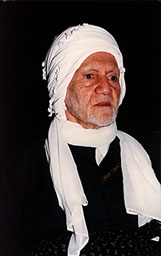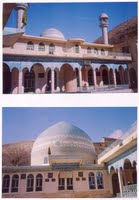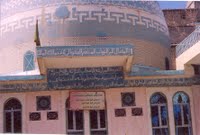Naqshbandis of Hawraman - part IIBy Farhad Shakely, "The Naqshbandi shaikhs of Hawraman and the heritage of Khalidiyya-Mujaddidiyya in Kurdistan Part II" - The Kurdish Globe - Erbil, Kurdistan, Iraq Thursday, December 18, 2008The Siraj ad-Dini ShaikhsThe Siraj ad-Dini sheiks have been the most prominent representatives of the Khalidi suborder in Kurdistan since the time Mawlana Khalid left Kurdistan for Damascus at the end of 1237 A. H./autumn, 1822.Indeed Shaikh Uthman Siraj ad-Din I (1195/1781-1283/1867) was the most important figure among Mawlana Khalid's disciples even at a time when Mawlana was still living in Kurdistan and/or in Baghdad. The two men knew each other as students of Islamic sciences (faqê in Kurdish), and they met once again in Baghdad in 1226/1811 when Mawlana stayed in the mosque of Shaikh Abd al-Qadir al-Gaylani five months, shortly after his return from India to Sulaimanî.It was then that Faqê Uthman, who afterwards was known as Siraj ad-Din I, was initiated to the path by Mawlana. After two years of spiritual training, he was the first person to become a khalifa (deputy) of Mawlana on the whole. He was then thirty three years old.Shaikh Uthman Siraj ad-Din was born in Tawêla, in Hawraman region, near Halabja. According to many sources his parents were descendants of the Prophet Muhammad. The family, thus, is a Sayyid family. But the Siraj ad-Dini Shaikhs never claimed being Sayyids. Shaikh Uthman signed his letters with his own name followed by al-Khalidi al-Mujaddidi an-Naqshbandi.Shaikh Uthman accompanied his preceptor during the years in which Mawlana was twice obliged to leave Sulaimani for Baghdad. In Sulaimani Shaikh 'Uthman usually substitued for Mawlana in the khatm assemblies. The disciples were instructed by Mawlana to attend Uthman's khatm circles. Among these were outstanding names like Sayyid Isma'il Daghistani, Mulla Abd al-Hakim Kashghari and Shaikh Muhammad of Halabja.Apparently Mawlana Khalid, who had much organisational ability, was preparing his disciple to succeed him and to take the difficult and crucial responcibility of spreading the order in Kurdistan.When Mawlana left Sulaimani for Baghdad for the last time in 1820, Shaikh Uthman did not follow him. He moved, instead, to his home region, Hawraman, and began to establish a strong base for the order, which became one of the most important centres for the Khalidi suborder in the whole Middle East and continued to be such untill the fifties of the present century. This centre not only contributed greatly in spreading the sufi teachings of the Naqshbandi order, but also produced a number of poets whose poems are examples of the most significant and marvellous sufi poetry as a whole.This indispensable position of Siraj ad-Din for Mawlana and for the order, becomes more clear when we know that during the summer months of 1236/1821 and 1237/1822 Mawlana left the heat of Baghdad for the summer resorts of Hawraman where he met Siraj ad-Din and supervised the Naqshbandi networks in Kurdistan. Shaikh Uthman also visited Mawlana in Baghdad, at least once, during this period.It was from Kurdistan, not from Baghdad, as it is commonly, but wrongly, accepted in the sources about the Khalidi suborder, that Mawlana Khalid went to Damascus.After leaving Sulaimânî in 1236/1822, Mawlana was represented in his Sulaimani khanaqa by Shaikh Abdullah Hirati (d. 1245/1839-40), who was assisted by Shaikh Muhammad Sahib (d.1283/1866), the brother of Mawlana. When Mawlana died in 1242/1827 Hirati, and a short time later also Sahib, left for Damascus. A few years later, in 1254/1838 the Baban Ahmad Pasha invited Shaikh Uthman to be in charge of the Khalidi khanaqa in Sulaimani. The Shaikh accepted the task and supervised the khanaqa, but he did not abandon Hawraman, to where he returned often.With the exception of those two years, Shaikh Uthman lived in Tawêla and Biyara, in Hawraman, from 1236/1820, the year Mawlana left Sulaimani for Baghdad, until his death, i.e. Shaikh Uthman's death, in 1283/1867. In nearly half a century he was the most prominent khalifa of Mawlana Khalid in Hawraman and Baban regions.The Shaikh had a great number of khalîfas and mansûbs /deputies and affiliates from different regions in Kurdistan and the Middle East. In his hagiography about Mawlana Khalid and the Naqshbandi Shaikhs of Hawraman, Malâ 'Abd al-Karîm-î Mudarris enumerates 96 khaiîfas and 33 mansubs of Shaikh Uthman. Among them we find many great 'ulama and poets but also two powerful rulers; Ahmad Pasha of Baban and Rizaquli Khan of Sina (Sanadaj) in Ardalan.This is contrary to what many researchers inferred, that the Naqshbandiyya was only an assembly for opposition sects in the Kurdish soceity.In addition to his letters there are a few lines of poetry and ten advisory articles by Shaikh Uthman, in which he instructes his disciples in the issues of the order. In one of these articles, dated 1272/1856, he appoints his sons Muhammad Baha' ad-Din and Abd ar-Rahman as his deputies and successors and advises his followers to obey them.Shaikh Uthman Siraj ad-Din I was succeeded in turn by five Shaikhs in his family. But it should be indicated also that other members of the family have been in charge of the path in different periods, with own disciples and khanaqas.He was succeeded directly by his son Shaikh Muhammad Baha' ad-Din (1252/1837 -1298/1881).Although in his testament, Siraj ad-Din had appointed two of his sons; Baha' ad-Din and Abd ar-Rahman Abu al-Wafa (1253/1837-1285/1868) to be his successors, but apart from a very short time, Shaikh Abd ar-Rahman declined the position and resided in Baghdad.He was a creating poet. The small amount of poems to which we have access today, some 70 poems in Persian, mostly ghazals, indicates his talent as a sufi poet. Baha' ad-Din also was a poet, although only a few of his poems are extant.The third Shaikh in the Siraj ad-Din silsila (initiating chain) was Shaikh Umar Zhia' ad-Din (1255/1839-1318/1901). He was distiguished from his predecessors in some aspects. It was in his time as a Shaikh that dhikr-i jahr (vocal remembrance) was practised besides dhikr-i khafi (silent remembrance). He was known for his enthusiasm for science and education, and for culture as a whole. He built several new khanaqas in Khanaqin, Kifri, Qizrabat, Biyara, Tawêla and Sardasht. He was a brilliant poet in Kurdish, Persian and Arabic. In his poems he used "Fawzî" as his takhallus (pen name).We have access also to some fifty letters written by him to his deputies or to the great men of his time, among whom we find the Qajari Shah Muzaffar ad-Din (reigned 1896-1907) and the Ottoman Sultan Abd al-Hamid II (reigned 1876-1909). There are, moreover, three treatises on sufi teachings.A remarkable feature in the life of Shaikh Umar Ziya' ad-Din was his good relation to the Qadiri Shaikhs and their disciples and followers, which will be dealt with later.The immediate successor in the chain was his son Shaikh Najm ad-Din (1280/1863-1337/1918) who was known for his zuhd (renunciation). The Ottomans wanted to give him a monthly salary to use it for the Khanaqa and its visitors, but the Shaikh rejected the offer.He had great interest in intellectual conversations with the scholars who so often visited the khanaqah in Biyâra. He was a poet, but the number of the poems available to us is very small.Shaikh Najm ad-Din was succeded by his brother Shaikh Muhammad Ala' ad-Din (1280/1863-1373/1954). He wrote a treatise in Arabic entitled Tibb al-Qulub (Healing the hearts) which contains advices and recommendations. He was a well-known phisician who helped thousands of people in the region and he prescribed them herbal medicine.When Shaikh Ala' ad-Din died in 1954 he was succeeded by his son Shaikh Muhammad Uthman Siraj ad-Din II (1314/1896-1417/1997), who was already a well-known and established sufi leader. Shaikh Uthman II was deeply learned in Islamic theology as well as in Kurdish and Persian poetry. He was moreover a skillful phisician with wide knowledge of herbal medicine.When the monarchy in Iraq was overthrown by General Abd al-Karim Qasim, Shaikh Uthman left Iraqi Kurdistan in 1959 and resided in Iranian Kurdistan about two decades. After the Iranian revolution he came back to Hawraman, Iraqi Kurdistan, but he soon left it for Baghdad.He spent the last seven/eight years of his life in Istanbul, where he died on 30 January, 1997. He was buried inside his residence, close to the khanaqa in Istanbul.Shaikh Uthman was also a poet; two volumes of his poems, in Kurdish and Persian, are published, as well as a volume of his treatises and letters entitled Siraj al-Qulub "Lantern of Hearts" of which an English translation is also published.Shaikh Uthman died almost simultaneously; as his brother Shaikh Mawlana Khalid, also a sufi leader, in Sanadaj, Iranian Kurdistan. No one of them knew, at least outwardly, about the death of his brother, and thus a great wish of their lives was fulfilled. Both had wished that he may never experience (the usual Kurdish expression here is not to see) the death of his brother. In tens of poems and hundreds of letters that were coming and going between them in the span of the last 70-80 years, they expressed that wish time and again. This was one of the last wondrous deeds (karamat) so often attributed to them throughout their lives. Shaikh Uthmân was 101 years old when he died and Shaikh Khalid was 99.Shaikh Uthman was named after his great-gradnfather Uthman Siraj ad-Dîn I and Shaikh Khalid was named after Mawlana Khalid.The role of the Naqshbandi Shaikhs of Hawraman in spreading and establishing the Naqshbandiyya-Mujaddidiyya-Khalidiyya in Kurdistan and in parts of the Middle-East is of central importance. It was under the guidance of them and their deputies that the order reached most of the regions in Iraqi and Iranian Kurdistan, Turkman Sahra in Iran, Northern Syria, Lebanon and Bosnia.Nevertheless, they still identify themselves as Khalidis and Mujaddidis, and never invented, or claimed to have invented, a new sub-order.Courtesy:Sufi News and Sufi World Report




